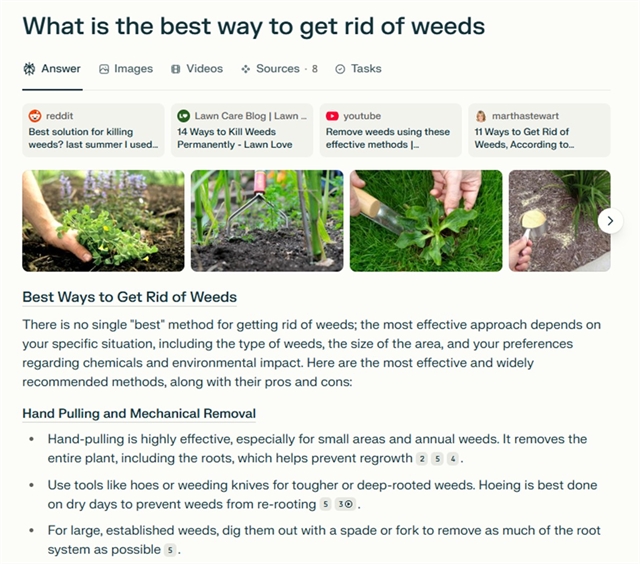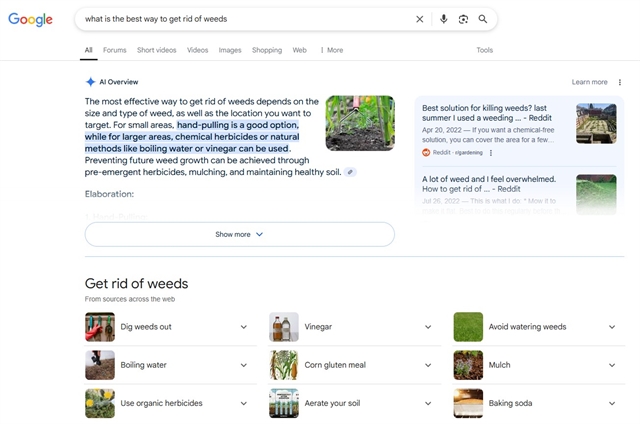Generative Engine Optimization (GEO) – also called answer engine optimization, or AEO – is shaking up digital marketing. If you’re used to optimizing for Google, it’s time to expand your playbook!
AI-powered tools like ChatGPT, Gemini, and Perplexity (just to name a few) now help people find answers and information online. GEO is all about making sure your content gets found and used by these tools.
What Is Generative Engine Optimization?
GEO involves creating content that AI engines can easily find, understand, and include in their answers. Traditional SEO focuses on ranking in search results and driving clicks. GEO focuses on getting your content referenced in direct, synthesized AI responses.
Here’s the main difference: SEO helps people find your website. GEO helps AI find your insights and share them directly with users. To succeed, your content must be clear, accurate, and trustworthy – so AI trusts it enough to use.
Here’s an example of an answer to a question posed on Perplexity. Note the sources referenced at the top of the answer result. These are the sources Perplexity is pulling its answer from:

How GEO and SEO Work Together
AI engines often pull from top-ranking SEO sources, so you still need to get noticed by Google and other search engines. GEO builds on SEO by:
- Answering common questions clearly and concisely
- Using structured data to understand your content’s context
- Making content easy for both humans and machines to digest and summarize
Why GEO Matters Now
AI is already part of the buyer’s journey. People use AI tools to research, find and compare products, and make decisions. If your content isn’t optimized for these tools, you’re missing out on valuable visibility.
GEO isn’t just a buzzword. It’s a practical shift in how people find information, and it isn’t going away. If you want to stay visible, your content needs to work for both search engines and AI.
The Impact of AI on Google
Google isn’t just a search engine anymore – it’s an answer engine. The company wants to satisfy user questions right on the search results page. That means your content needs to adapt to directly answer specific questions and be concise, clear, and easy for AI to summarize.
Getting the top organic search result is no longer the only goal. Now, you want your content to be the answer, not just an option, and appear in a variety of evolving SERP features. Learn more about the latest SERP features in this brief video.
Here’s an example of results for the same question we posed to Google above about the best way to get rid of weeds. The result includes a variety of SERP features, including an AI overview, as well as additional information below and “Learn more” sources on the right-hand side. All of this before you even see the top organic link.

This shift from displaying links to providing answers continues to evolve as it aims to provide users with the best possible experience.
So, Is SEO Dead?
Not even close! SEO is still essential and continues to drive significant traffic to sites. The fundamentals of SEO – quality, relevance, and authority – haven’t changed. What’s changing is how you apply them.
Here’s what hasn't changed. Make sure to:
- Create high-quality, trustworthy content.
- Stay up to date with search and AI platform changes. (Subscribe to our blog for regular updates and insights.)
- Diversify your formats – think blogs, videos, infographics, and structured data.
- Focus on user intent and deliver real value.
- Make your content relevant and easy to understand for both humans and machines.
GEO is an evolution of SEO, not a replacement. Keep investing in SEO but start thinking about how your content can serve both traditional searchers and AI-powered platforms.
Navigating the Future
GEO is here to stay. Marketers who adapt will find new opportunities to connect with audiences, whether those audiences are people, AI, or both.
Think of Generative Engine Optimization as the next step in search strategy. It doesn’t replace SEO – it builds on it. Make your content clear, trustworthy, and ready for both search engines and AI, and you’ll be ready for whatever comes next.
Need help crafting a modern search strategy that gets results? Reach out! Our content and SEO/GEO strategy experts are ready to help you achieve your goals.






